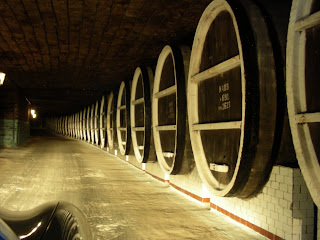 The Roman Emperor Trajan is most famous for his defeat of the Dacians in what is present day Romania, Moldova and parts of Bulgaria. He has a monument in Rome in his own Forum marking the event, neither of which I've yet seen.
The Roman Emperor Trajan is most famous for his defeat of the Dacians in what is present day Romania, Moldova and parts of Bulgaria. He has a monument in Rome in his own Forum marking the event, neither of which I've yet seen.I did however get to visit the Colosseum, or the Flavian Ampitheater as it is properly called, on a recent layover on my way to Moldova. It was a fitting stop, as Trajan apparently held games there commemerating his victory involving 7,000 gladiators and 10,000 wild animals.
The Flavian dynasty was founded by Emperor Vespasian, famous for his involvement in the Roman conquest of Britain, as well as the Siege of Jerusalem and the fall of Masada, led by his son Titus. Ironically, Vespasian's son Domitian is known for being unable to defeat the Dacians led by King Decebalus whom Trajan later destroyed. Titus later reigned during the eruption of Mount Vesuvius which buried Pompeii.
Vespasian constructed the modern day Colosseum as a way to entertain the rebellious masses who had played a key role in overthrowing his predecessor Nero. Performances were accompanied by free bread and wine for all attendees, part of the origins of the term "bread and circuses". Entrace was also free. Seating was by social status, with the nobility at ringside and the poorest women on the fourth or uppermost tier. There were 64 numbered doors to let spectators in and out that were called vomitoria. Door numbers corresponded with where citizens lived in the city, so each person knew their place.

The tallest Roman structure, the Colosseum could hold 87,000 spectators and several hundred wild animals. The colosseum was about 160 feet high and covered about six acres. For all that, the first thing I noticed when I visited was that it is much smaller than I had imagined it. After Soldier Field, it seemed quite cozy. Movable awnings called velarium manned by imperial sailors provided the spectators with shade from the sun. The outside of the Flavian amphitheater has three rows of arches, each built according to a different order of architecture, Doric, Ionic, and Corinthian.
There were substructures under the fighting areas that included animal dens. Recent research suggests that contrary to popular belief Christians were not generally fed to wild animals in the Colosseum. However, it was a common sentence for most crimes during the period in the Roman Empire, and feedings occured during the mid-day break and at the end of the day's events. For centuries the Colosseum was marked by shrines to Stations of the Cross and the Pope today begins his visit to Stations of the Cross in the Colosseum on Good Friday.

Before he held his celebration in the Colosseum, Trajan first journeyed to Romania and defeated the Dacians. He made the journey on foot with a mixed army of Romans and foreign mercenaries. I thought about this as I was flying to Moldova, as I found my American Airlines tickets were sold and resold to subcontracting Hungarian, Italian and Moldovan airlines. I wondered if Trajan wondered who he was actually fighting for when he finally arrived?
Fortunately, Moldova has a tremendous wine-making industry that was brought to the world stage under the Roman Empire. It has blossomed since the collapse of the Soviet Union and exports all over the world. One local variety, Negru de Purcari, has been ordered by the British royalty
 since Queen Victoria. This apparently makes it very popular with today's Japanese.
since Queen Victoria. This apparently makes it very popular with today's Japanese.During my trip I made a visit to Miliestii Mici, the largest wine collection in the world, where you take the cellar tour in your car driving through the barrels. The tour is topped off with a four course meal and a variety of wines on offer and samples to take home. Fortunately, I had my wine travel bag so my bottles made it home safely.

No comments:
Post a Comment